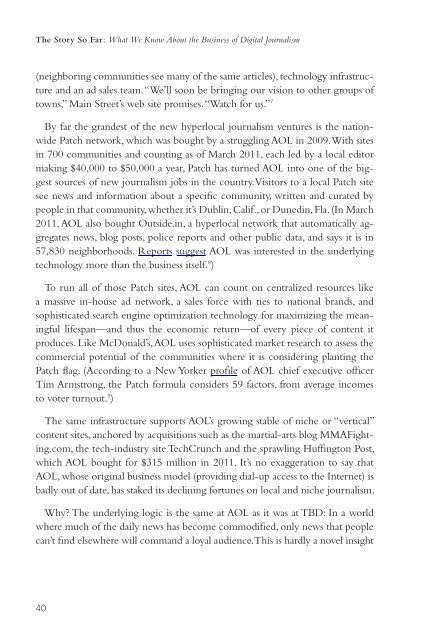What We Know About the Business of Digital Journalism
What We Know About the Business of Digital Journalism
What We Know About the Business of Digital Journalism
You also want an ePaper? Increase the reach of your titles
YUMPU automatically turns print PDFs into web optimized ePapers that Google loves.
The Story So Far: <strong>What</strong> <strong>We</strong> <strong>Know</strong> <strong>About</strong> <strong>the</strong> <strong>Business</strong> <strong>of</strong> <strong>Digital</strong> <strong>Journalism</strong>(neighboring communities see many <strong>of</strong> <strong>the</strong> same articles), technology infrastructureand an ad sales team. “<strong>We</strong>’ll soon be bringing our vision to o<strong>the</strong>r groups <strong>of</strong>towns,” Main Street’s web site promises. “Watch for us.” 7By far <strong>the</strong> grandest <strong>of</strong> <strong>the</strong> new hyperlocal journalism ventures is <strong>the</strong> nationwidePatch network, which was bought by a struggling AOL in 2009. With sitesin 700 communities and counting as <strong>of</strong> March 2011, each led by a local editormaking $40,000 to $50,000 a year, Patch has turned AOL into one <strong>of</strong> <strong>the</strong> biggestsources <strong>of</strong> new journalism jobs in <strong>the</strong> country. Visitors to a local Patch sitesee news and information about a specific community, written and curated bypeople in that community, whe<strong>the</strong>r it’s Dublin, Calif., or Dunedin, Fla. (In March2011, AOL also bought Outside.in, a hyperlocal network that automatically aggregatesnews, blog posts, police reports and o<strong>the</strong>r public data, and says it is in57,830 neighborhoods. Reports suggest AOL was interested in <strong>the</strong> underlyingtechnology more than <strong>the</strong> business itself. 8 )To run all <strong>of</strong> those Patch sites, AOL can count on centralized resources likea massive in-house ad network, a sales force with ties to national brands, andsophisticated search engine optimization technology for maximizing <strong>the</strong> meaningfullifespan—and thus <strong>the</strong> economic return—<strong>of</strong> every piece <strong>of</strong> content itproduces. Like McDonald’s, AOL uses sophisticated market research to assess <strong>the</strong>commercial potential <strong>of</strong> <strong>the</strong> communities where it is considering planting <strong>the</strong>Patch flag. (According to a New Yorker pr<strong>of</strong>ile <strong>of</strong> AOL chief executive <strong>of</strong>ficerTim Armstrong, <strong>the</strong> Patch formula considers 59 factors, from average incomesto voter turnout. 9 )The same infrastructure supports AOL’s growing stable <strong>of</strong> niche or “vertical”content sites, anchored by acquisitions such as <strong>the</strong> martial-arts blog MMAFighting.com,<strong>the</strong> tech-industry site TechCrunch and <strong>the</strong> sprawling Huffington Post,which AOL bought for $315 million in 2011. It’s no exaggeration to say thatAOL, whose original business model (providing dial-up access to <strong>the</strong> Internet) isbadly out <strong>of</strong> date, has staked its declining fortunes on local and niche journalism.Why? The underlying logic is <strong>the</strong> same at AOL as it was at TBD: In a worldwhere much <strong>of</strong> <strong>the</strong> daily news has become commodified, only news that peoplecan’t find elsewhere will command a loyal audience. This is hardly a novel insight40
















